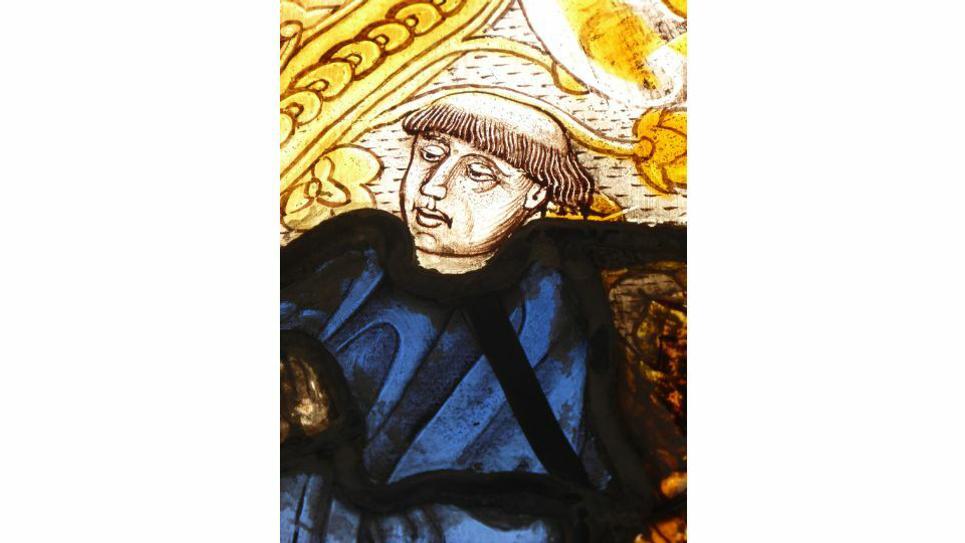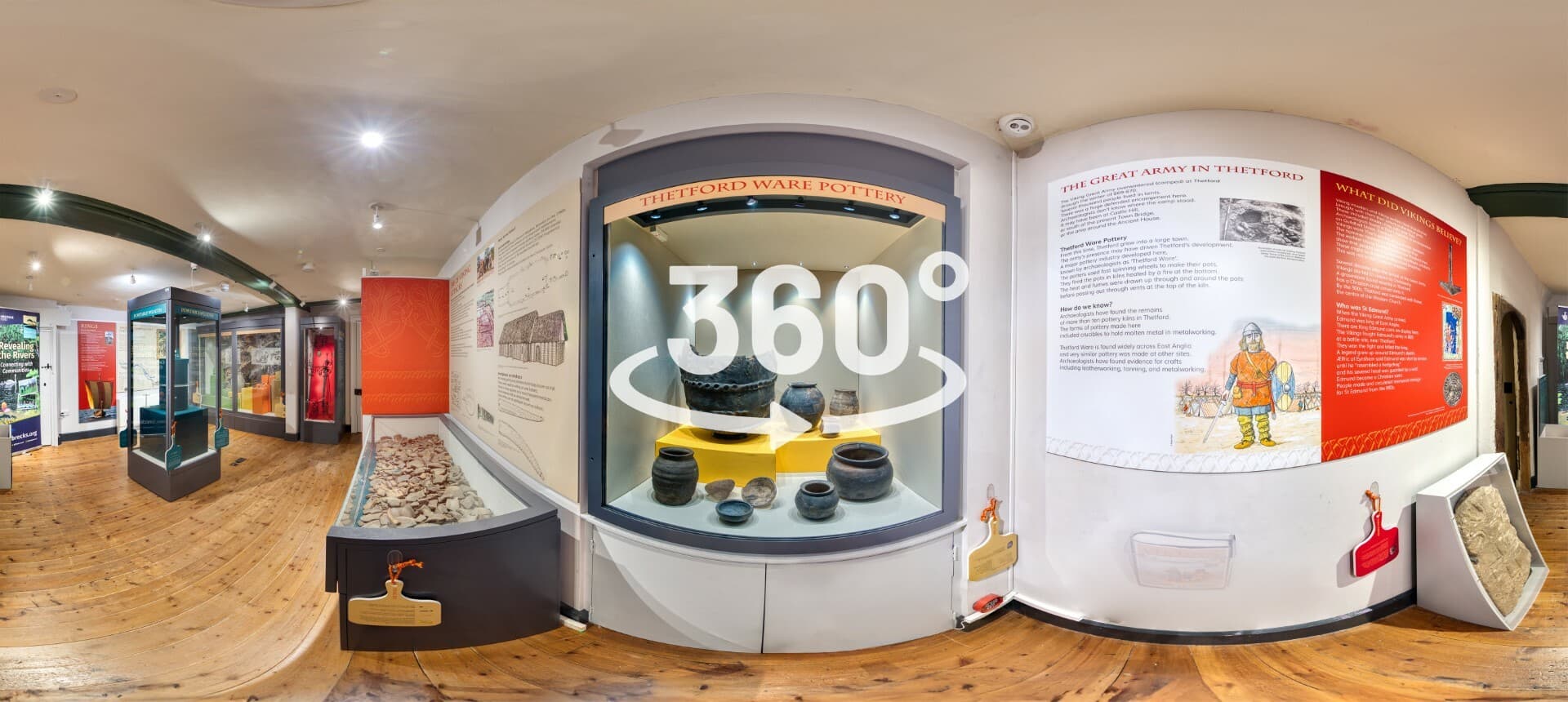
Back to Blogs
Discover
Mystery of the Lost Stained Glass
By Martin Harrison and Francis Young
All Saints’ Church in Brandeston, like many Suffolk churches, contains a number of fragments of medieval glass that were set into windows in the 19th and 20th centuries when it became fashionable to recover the medieval past. The glass at Brandeston is not original to the church, as it was not mentioned by the antiquary Robert Hawes (1665-1731), who wrote about the church in 1725. This is also common; fragments of medieval glass set into modern windows often come from other churches. In the case of Brandeston, however, there is an intriguing possibility that the glass comes from the Abbey of Bury St Edmunds itself – and, specifically, from the Abbey’s Chapter House. The Chapter House was where the monks gathered to make important decisions, and also hosted Parliament on several occasions.
In 1950 Christopher Woodforde reported that there was, or had been, a series of fragmentary depictions of Bury’s abbots in the glass at Brandeston, including Abbots William Curteys (ruled 1429–46), Thomas Rattlesden (ruled 1479–97) and William Bunting (ruled 1497–1513). Only one depiction of an abbot now survives, along with a single tonsured monk. Both the style of the glass and the survival of a fragment featuring the pomegranate badge of Queen Catherine of Aragon confirm that the glass set in a window on the south side of the nave dates from the reign of Henry VIII, and therefore from the very last years of St Edmunds Abbey when Bury was ruled by Abbot John Reeve.

Copyright Martin Harrison
The theme of the glass strongly suggests that it comes from Bury; while it is not impossible that an individual abbot with an association with a parish church might have been depicted in its stained glass, it seems very unlikely that a series of abbots would be found anywhere other than the Abbey; and the place in the Abbey where such a theme was most likely was the Chapter House, where the abbots were traditionally both elected and buried. However, in the absence of any firm evidence, the idea that the glass fragments at Brandeston come from Bury’s Chapter House must remain speculation.

Copyright Martin Harrison
What we do know is that most of the monastery had to be re-glazed between 1465 and the dissolution in 1539, on account of a disastrous fire in the abbey church that destroyed the ancient glass. For this reason we should expect surviving glass from the Abbey to date from the late 15th or early 16th centuries – the era of the Brandeston glass. Glass was expensive in the 16th century, and the stained glass of an enormous church like St Edmunds Abbey would not simply have been smashed and left where it fell. Instead, along with the other materials from the monastic buildings, the glass became the property of the Crown at the time of the dissolution, and some of it was taken away and sold.
The surviving fragments at Brandeston depict a tonsured monk with a fragment of inscription above him and an abbot kneeling before an open book, dressed in a ‘Canterbury cap’ (ancestor of the academic mortarboard) and holding a crozier. This would have been an abbot’s everyday dress, as opposed to the cope and mite an abbot wore on special occasions. Although no identifying inscription survives for the abbot, careful study of the image revealed a Latin inscription in the book that lies open before the abbot, which reads ‘I write the life of St Edmund, king and martyr for the world’. Since Abbot William Curteys was the only abbot of St Edmunds who wrote a life of St Edmund, this inscription leaves little room for doubt that the abbot portrayed is Curteys. Abbot Curteys is best known as the patron of the monk-poet John Lydgate, and as the abbot who built a new library and welcomed the boy-king Henry VI to the Abbey in 1433. The fragment of Latin inscription above the tonsured monk reads either Abbat[ia] S[ancti] E[dmundi], ‘the Abbey of St Edmund’, or Abbat[is] S[ancti] E[dmundi], ‘of/belonging to the Abbot of St Edmunds’.

Copyright Martin Harrison
Abbot Curteys’s life of St Edmund was not a well-known work, and its portrayal in this stained glass strongly suggests the glass came from the Abbey, since a detail of this kind would have been appreciated primarily by the monks; in all likelihood, this was an image created for internal viewing by the monastic community – especially since the abbot is in everyday dress. Whatever happened to the other abbots that apparently once formed part of the series, a portrait of Abbot Curteys at Brandeston that very probably comes from glass originally installed at Bury is a remarkable survival, and it provides an insight into how Bury commemorated its past abbots, perhaps even in the Chapter House itself.
1000 years since the founding of the Abbey of St Edmund will be marked with a year of celebrations in 2022. Find out more with our Abbey 1000 Guide!
Related Blogs

News
Abbey Project Awarded…
The project aims to conserve and protect the ruins;…

News
Cycle the Wolf Way
Winding its way around many of the best bridleways,…

News
360° Degree Vikings
The Brecks Fen Edge and Rivers Landscape Partnership…

News
Dame Barbara Woodward DCMG…
Dame Barbara Woodward DCMG OBE Announced as Speaker at…

News
Celebrate St Edmund's Day on…
St Edmund's Day is celebrated around the world every…
Latest news

News
Discover Suffolk's County Flower - the Oxlip
Did you know that Suffolk has a county flower? The Oxlip only grows in some woodland areas of Suffolk, Cambridgeshire and Essex.

News
Quentin Blake ‘The Illustrated Hospital’ exhibition at Bury St Edmunds Museum
A summer exhibition of illustrations by Quentin Blake at Moyse’s Hall Museum, Bury St Edmunds presents a rare opportunity to view a large collection of pieces by one of the nation’s favourite artists.

News
Abbey Project Awarded National Lottery Heritage Fund Grant
The project aims to conserve and protect the ruins; build a visitor centre, west cloister, and network of footpaths; and use digital technology to provide exciting interpretation for all ages and…

News
Walks at Rougham
Rougham Estate offers 18 miles of public footpaths, cycling routes and permissive pathways for you to enjoy.

News
Bury St Edmunds Celebrates English Tourism Week
Bury St Edmunds MP, Jo Churchill, met representatives from the town’s attractions and tour guides involved with the town’s Masters of the Air tourism campaign at Bury St Edmunds Guildhall.

News
Tours Take Off for Masters of The Air
Tours developed by Bury St Edmunds Tour Guides and Bury St Edmunds Guildhall to tie in with the Apple TV Series Masters of The Air so popular more dates are being added.

News
International illustrator David Hughes draws largest exhibition Bury St Edmunds
The largest ever exhibition is now underway at Moyse’s Hall Museum featuring the work of internationally acclaimed illustrator David Hughes.

News
A Taste of Bury St Edmunds and Suffolk
After visiting Suffolk's foodie capital, you'll want to take it with you - here are 5 foodie treats to take home!

News
Doctor Who Stars Coming to Bury St Edmunds to Star in Sherlock Holmes Classic
Who stars Colin Baker, Terry Molloy, and Rosie Baker will star in Hound of The Baskervilles at Bury St Edmunds Theatre Royal
